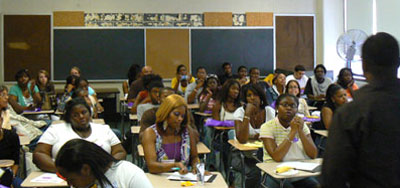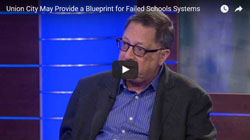Featured Book
Improbable Scholars
The Rebirth of a Great American School System and a Strategy for America’s Schools
How do we determine if our schools are preparing students for a meaningful future in our society? How can we improve schools that are not living up to those standards? David Kirp explores the current crisis in American education, with a close look at four districts that have made positive changes.
Highlighting the improbable success in Union City, New Jersey, a poor, crowded, Latino community that was once one of the worst in the state, Kirp introduces us to the individual students, teachers, administrators and politicians who built a system that defied expectations, raised performance levels, and produced schools the whole community could be proud of, and other districts might envy. This book reveals not a blueprint, but a sensible approach for rebuilding public education and closing the achievement gap in struggling districts.
The Real Crisis in American Education
In Kirp’s view, the real crisis lies in our failure to adequately educate poor, racial minority and immigrant youngsters.
It is common knowledge that we are in the midst of a crisis in education, yet there is little agreement on the causes, effects, remedies or even the symptoms of that crisis. Critics lambaste the public schools as fossilized bureaucracies run by paper pushers and filled with time-serving teachers preoccupied with job security rather than the education of their students. The education crisis has been linked to a grab-bag of dire predictions about national security, prosperity, world status, freedom of choice and integrity of the very fiber of American society. From the Federal government on down, we have been force-fed a bewildering array of programs laced with slogans like Accountability and No excuses.
Schools and districts are threatened with government takeover, loss of funding, teacher firings, curriculum mandates, and cancellation of arts and athletics, all in the name of addressing the crisis. Yet even the most basic question, How can we determine if a school is succeeding or failing? stirs up a storm of controversy, rooted in our fundamental disagreements over what we expect from our education system.

In Kirp’s view, the real crisis lies in our failure to adequately educate poor, racial minority and immigrant youngsters. Non-Caucasians now constitute the majority of students in public schools in the United States. The percentage of school age children living in poor or near-poor households has increased to 42%, with some groups suffering the double disadvantage of poverty and race: 37% of black and 34% of Hispanic students live below the poverty level, as well as 14% of Asian and 12% of white. Many immigrant children also are poor and/or non-white, and have an added burden if their English skills are deficient. And across the country, non-white, poor and immigrant students attend the worst-performing schools, in higher numbers.
While the demographics are changing, school funding has been decreasing. For example California, which once enrolled a white majority and boasted the best-funded schools in America, now has twice as many Hispanic students as whites in public schools, and its per-student spending has dropped to 47th in the nation. These trends reinforce each other over time: while populations have increased more rapidly in poorer areas, affluent citizens increasingly resist paying higher taxes to support less fortunate students.
While populations have increased more rapidly in poorer areas, affluent citizens increasingly resist paying higher taxes to support less fortunate students.
Dropout rates too are on the rise. Nationwide, 30% of all students drop out before graduating from high school, and it is not surprising that a disproportionate number of those dropouts are the under-served poor, non-white and immigrants. The dropout figures clearly hurt us all economically: Over the course of a lifetime a dropout will earn an average of $700,000 less than a high school graduate, and will cost society nearly $300,000 in lower tax revenues, additional governmental benefits and incarceration costs. If we fail to prepare these students for participation in a high-tech economy, in the near future we will all be paying the price. The attitude that this is their problem, not ours is misguided and dangerously myopic.
How We Judge Success

Just as there is a lack of consensus about the problems, there is also lack of agreement over what constitutes success, how to achieve it and how to measure it. Into this controversy different levels of government have poured programs establishing standards and enforcing them through financial, legal, political and staffing incentives and penalties. The main yardstick is standardized testing. These tests have now taken on a high pressure, high stakes aspect that drives policy choices all over the country. Educators and parents fear that important educational values, such as curiosity, deep understanding and creativity are being sacrificed in favor of testing quotas.
Is high stakes testing part of the solution, or is it making the problem worse? Kirp acknowledges the downside of testing and presents evidence that the relentless pressure and narrow focus can be destructive to our broader goals for education. Yet he thinks testing can also be a force for good, especially for the have-less kids on whom schools too often have given up. Everything depends on what is being measured and how much weight is given to the results. He believes high stakes exams contributed to making the schools better in Union City, but Government policy has now shifted from a virtual absence of accountability to a truncated view of what our schools should be held accountable for. Regardless, Kirp sees testing programs as a present day force that must be reckoned with – there is simply too much at stake to ignore these mandates while they prevail.
Examples of Progress
Besides Union City, Kirp explores Aldine, Texas; Montgomery County, Maryland; and Sanger, California. All four districts have been in jeopardy because of low test scores. While none of them is completely out of the woods yet, all have made significant progress, despite their quite different profiles.
A long-standing problem in American education is a widespread provincialism, the belief that the circumstances in one’s own district are so idiosyncratic that no lessons can be learned or tactics borrowed from anywhere else. Kirp’s study includes districts that are dissimilar in such fundamental factors as size, per-pupil spending, ethnic mix and economic health, and yet there is notable commonality in the reform strategies they have adopted.
What Works
Effective districts don’t seek to copy other programs, but borrow solid principles that have been shown to work. They develop coherent systems from preschool through high school, based on their particular demographic and political realities, and they make extensive use of data to evaluate and refine their programs over time.
- Plan, do, review: The most important factor is adequate time to plan, implement and evaluate reforms. There are no quick solutions that are truly effective, because there are no simple ones. The reasons why schools succeed or fail are highly complex; time is needed for any system that will be sufficiently sensitive and robust. A weary public wishing for shortcuts should beware of simplistic approaches.

- Use of data: There is extensive, ongoing use of data to identify problems and successes, pinpoint the needs for change, and follow up on results, all elements of the plan-do-review model.
- Consistent curriculum: Curriculum is challenging, consistent from school to school, and tied together from one grade to the next. Many poor and working class families move frequently, and each change of school can result in interrupted learning and missed opportunities. Consistency works best when the curriculum is developed by teachers and experts within the district, to meet the particular needs, fostering acceptance and a shared stake in the process.
Noted economists have estimated the return on investment for quality preschool as high as seventeen-to-one.
- Support for teachers: Consistent curriculum allows teachers more support from their peers and administrators, through coordinated lesson plans and materials, team teaching, in-class coaching and brainstorming. While some teachers resist enforced consistency as an invasion of their own domains, statistics show that the overall quality of teaching tends to rise with the team approach.
- Committed leadership and student-centric outlook: Leadership is strong at both the school level and higher, with a priority on students’ needs over the preferences of staff and political objectives. Autocratic and fear-based management styles are put aside in favor of team building and mutual respect. The best leaders hire competent staff, give them significant responsibilities, and then support them to success. The most effective principals can be seen in the classrooms, hallways, playgrounds and auditoriums as well as their offices. Likewise at the district and government levels, there are competent administrators willing to dive into the details of reform and build working alliances to effect change over time.

- Quality preschool: There is a commitment in these districts to quality preschool programs. For children from poor families, attending a well designed preschool program boosts educational achievement throughout K-12, and correlates into adult life with economic benefits and lower rates of drug dependence and incarceration. The districts see significant economic benefits because of a lower demand for remedial services, repeated course work, and so on. Noted economists have estimated the return on investment for quality preschool as high as seventeen-to-one.

- Positive vision: A culture is built that combines high expectations with respect for all and a “we can do it” emphasis on the positive. Schools reach out to parents; administrators partner with faculty. There is a team approach to curriculum development, teaching and learning. The schools become a shared source of pride in the community.
- Stability over drama: Districts that successfully raise their achievement levels foster stability and minimize political drama. They hire administrators who are in it for the longer term, with a vision that extends beyond election cycles. Success ultimately depends on coordination and buy-in at multiple levels of the community, and on trust that must be built over time.
What Doesn’t Work
Studies show no significant difference between performance from charters and public schools.
- Simplistic approaches: The reasons why schools fail are too complex to be solved with single issue or simplistic programs.
- Exact copies: Districts differ in complex ways. Successful districts borrow techniques that have been proven elsewhere, but must adapt and fine-tune them to their specific circumstances.
- Charters and vouchers: Although there has been a great rallying cry around charter schools and voucher programs, studies show no significant difference between performance from charters and public schools. Voucher programs fare worse than charters because private schools are often unregulated as to curriculum and evaluation. At the lowest end of the performance scale are the online “virtual” charter schools.
- Get-tough policies on teachers and principals: Firings, denial of tenure and other penalties on faculty, whether they might be justified in individual cases, have been shown not to be an effective tool in improving school performance. Many high profile slash-and-burn administrators, despite apparent short-term gains and publicity, eventually leave their districts even worse off for their punitive policies. Districts that are successful in the longer term use a supportive team approach and provide extra resources for staff instead of penalties.

- High pressure to achieve quickly: News stories about systematic cheating on tests and artificial boosting of graduation rates have driven home the obvious: If districts are forced to produce results that are unrealistic, if they are not allowed enough time for legitimate improvement, and if the penalties for failing are severe, a strong incentive to cheat is built into the program. Even for districts that don’t resort to cheating, unrealistic pressures will shift the focus toward maximizing test scores at the expense of nurturing a robust overall educational system. This is the tail wagging the dog, when programs to improve quality in flagging districts result in degrading them even further.
Kirp follows Union City’s efforts in detail over more than a year, with personal experience in the classrooms as well as plenty of journalistic digging. He believes the lessons learned in Union City can serve as a working example for other districts. He also hopes to further the national discussion about accountability programs: what we are and are not willing to accept as we strive for improvements in American education.
In the series: Health and Education in the Modern World
Further Reading »
External Stories and Videos

Watch: Union City May Provide a Blueprint for Failed School Systems
David L. Kirp NJTV News
The announcement that the state will take over Camden’s public schools turned attention to one of the most troubled school districts in the nation. University of California professor David Kirp points to Union City as one of the unsung success stories in public education.

